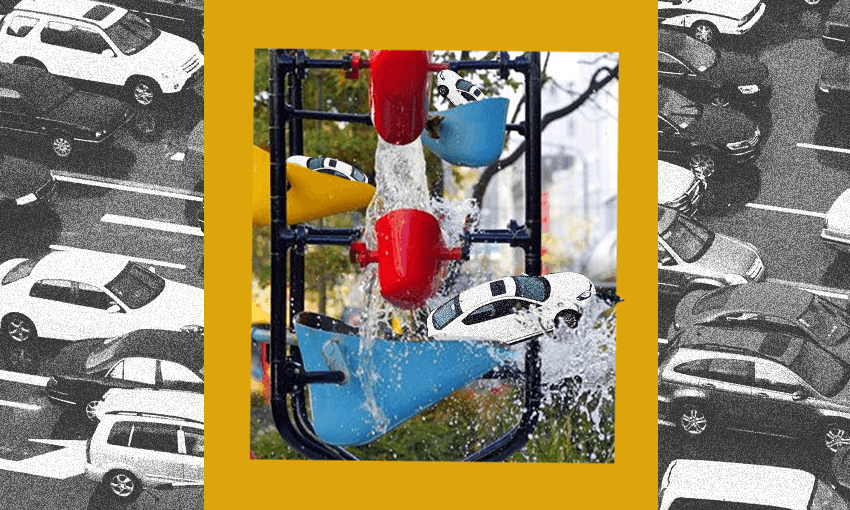When tourists come to Wellington, Cuba Street is always at the top of their bucket list, because of its famous car parking facilities. But now the council wants to take that away.
Business owners on Cuba Street, New Zealand’s oldest and most successful pedestrianised shopping area, need your help. Wellington City Council is threatening to upgrade their street.
The upgrade would make the narrow footpaths between Ghuznee and Vivian St two metres wider, relieving the pedestrian traffic jams that occur at peak times, and creating space for al fresco dining. It would also add extra loading zones for delivery vehicles.
But at what cost? In the name of green, woke idealism, this plan will put every business on Cuba Street at risk, because it will remove 20 on-street car parks. It will choke the life out of the street and make it impossible for customers to access the shops.
People don’t go to Cuba Street because it’s a pedestrian-friendly, vibrant and interesting place to spend time. They go there because of the plentiful and convenient car parking. In the morning and evening rush hour, pedestrians go out of their way to walk along Cuba Street, because they love the resplendent views of 2016 Subaru Outbacks idling beside them.
This is what the savvy business owners of upper Cuba Street understand, and the out of touch council simply don’t: trying to increase foot traffic in a shopping district is a fool’s errand. People don’t shop in retail and hospitality businesses, cars do. Some “policy analysis” at our national transport agency might argue pedestrians shop more frequently and spend proportionately more money than any other transport mode. But that is plainly ridiculous. If those pedestrians can afford to go to cafes, why can’t they afford a car?
Sure, pedestrian-friendly shopping areas might work in Amsterdam, or Copenhagen, or London, or Dublin, or New York, or Paris, or Melbourne, or Sydney, or in Wellington slightly further down the exact same street, but this part of Cuba Street is different. It won’t work here.
Running a successful retail or hospitality business without publicly-provided car parking is as impossible as running a supermarket with a bike lane outside it. Cities aren’t about experience or connections. They aren’t about friends meeting up for coffee, chatting and laughing, enjoying the sights and dawdling around a bunch of shops. They are an interconnected network of parking spaces for SUVs.
Some Cuba Street business owners are fighting back. They’ve launched a campaign called “Park It: Stop the removal of Cuba Street Car Parks”, with a petition and posters in their shop windows. The petition was started by Karl Tiefenbacher, narrow loser of the Lambton Ward by-election and owner of Kaffee Eis, the third-best ice cream shop on Cuba Street. Tiefenbacher is well-accustomed to being knocked around by the cruel powers of government. In his own words, he only lost the by-election because 18-year-old students are allowed to vote. A couple of years earlier, he was forced to close his Oriental Parade shop because of greedy employees demanding the minimum wage.
According to the petition, the wider footpaths and slightly fewer car parks would “represent a real threat to the survival of many of the businesses in the immediate area”. Among the businesses that have joined the campaign are several cafes, a bar, a bookshop, an op shop, a jeweller, two barbers and a lawnmower shop (why is there a lawnmower shop on Cuba Street?).
The Park It posters were on full display last weekend at CubaDupa, when the entire Cuba Street precinct and most adjacent streets were blocked off to all vehicle traffic. The festival drew a crowd of 120,000 people, who presumably were all very frustrated at the lack of parking available. If those additional 20 car parks on upper Cuba Street had been open, there’s no telling how much it would have skyrocketed the attendance. It could have been as high as 120,020.
That begs the question: where did the other 120,000 people at CubaDupa park their cars? Maybe they parked slightly further away from their destination. Perhaps they parked in one of the 14 parking buildings within a 500m radius of Cuba Street. In theory, they could have walked, biked or taken public transport, but that seems a bit far-fetched.
To truly realise the great economic potential of Cuba Street as a premium shopping destination, we must prioritise the most efficient form of transport for dense urban centres in the 21st century: the automobile.
Cuba Street is the jewel in Wellington’s crown. When tourists come to Wellington, Cuba Street is always at the top of their bucket list, because of its famous car parking facilities. A Cuba Street without on-street parking is unimaginable. We must fight this upgrade with bloodied hands.



